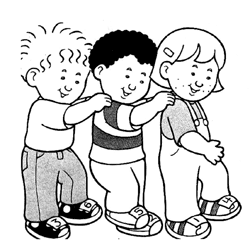
|
Fun Time
As a bug walks, three legs support the weight of the body while the other three legs swing forward to a new position. To walk like a grasshopper, ant, or ladybug try this:
Form a line with two helpers, one behind the other. Place your hands on each other's shoulders.
Adult step. Write the numbers 1 through 6 on the labels. Place the labels on the children's shoes as shown.
Adult step. Instruct the children to walk using the feet that you tell them to lift.
- First lift and move forward feet 1, 3, and 5.
- Next, lift and move forward feet 2, 4, and 6.
- Repeat the steps several times.
This experiment was taken from Janice VanCleave's Play and Find Out About Bugs and used by permission of the publisher, John Wiley & Sons, Inc.
For more information about insects, check out Janice VanCleave's Insects (ages 8-12) and Janice VanCleave's A+ Projects in Biology (ages 13 and up).
|
Q: With six feet, why don't bugs step on their own feet?
A: Bugs with six legs balance on just three of their legs, if they are the correct ones. The three legs that they must keep on the ground are the front and hind legs on one side plus the middle leg on the opposite side. They can raise the three other legs to walk. So, they have room to move their legs and walk without stepping on their own feet.
The term "bug" is often loosely used to mean any small creepy crawler. Bugs belong to a group of animals called arthropods. Arthropods makeup more than three-fourths of all kinds of animals and include such familiar bugs as insects, spiders, centipedes, and millipedes. These bugs are different in many ways, including the number of their legs. Insects have six legs and spiders have eight. While the name centipede means 100 feet, these bugs can have many more than 100 feet but most have fewer than 50. While some centipedes do have 100 feet, no millipedes have 1,000 feet as their name implies.
Bugs on land move from place to place by walking on legs. The fewer and longer the legs are, the harder it is for the animal to balance. Spiders stand on four legs at a time, two on each side (first and second on one side and second and fourth on the other side). The other four legs do not all move together. Instead they move in a wavelike motion, with the first leg coming down about the time the fourth leg is being lifted. A general principal of walking for animals with four or more legs is that alternate legs are lifted and no leg is moved until the one behind it is in supporting position.